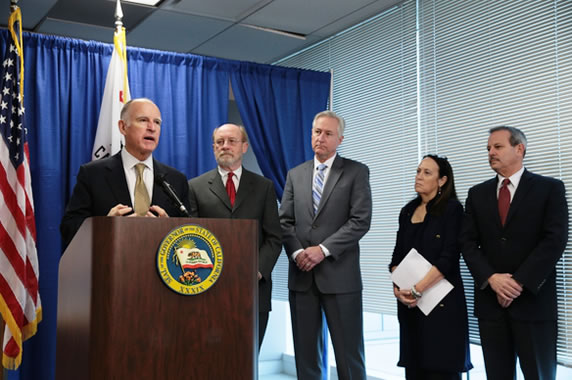
With California facing water shortfalls in the driest year in recorded state history, Governor Brown today proclaimed a State of Emergency. (Photo courtesy California Office of the Governor)
Speaking at a San Francisco news conference on January 17th, California Governor Jerry Brown officially declared a drought emergency in the state. Brown called on all citizens to voluntarily reduce their water use by at least 20%. 2013 was the driest year on record in California with San Francisco receiving the least amount of rain since the city began keeping precipitation records. The drought announcement comes on the heels of a landmark proposal requiring the insulation of hot water piping in new buildings in an effort to conserve water.
The proposal, put forth by the United Association of Journeymen and Apprentices of the Plumbing and Pipefitting Industry (UA) and the Natural Resources Defense Council (NRDC), would save energy and water in new buildings. The two organizations jointly submitted the proposal to the International Association of Plumbing and Mechanical Officials (IAPMO).
In a statement, the groups said Americans waste millions of gallons of water by letting water run until it’s hot enough for use in showers and sinks. To curtail this waste in new buildings, NRDC and the UA proposed that the 2015 edition of IAPMO ‘s Uniform Plumbing Code require insulation of all hot water piping systems such as those serving lavatories, showers, dishwashers, and kitchen sinks. The Uniform Plumbing Code is the model for local and state plumbing codes now in force in at least 19 states.
Mike Massey, Executive Director of the Piping Industry Progress and Education Trust Fund and a member of the World Plumbing Council Executive Board told High Rise Facilities: “The recent proposal is groundbreaking in that a major trade union and environmental organization are joining forces to save water and energy.” Massey, who frequently represents the UA in Green Building-Energy Efficiency-Environmental matters went on to say, “The UA has long been involved in energy efficiency. In fact, water conservation and energy efficiency have long been part of the union’s training program.”
Peter Lehner, Executive Director at the Natural Resources Defense Council, commented: “Most of us waste too much time, energy and money waiting for hot water to come out of our faucets and showers. By combining efficient designs, proven energy-saving materials, and skilled labor, we can build smarter buildings that curb this waste and improve the amenity of new buildings. This proposal will not only save homeowners and renters money on their monthly utility bills but also protects our environment by cutting energy and water use.

